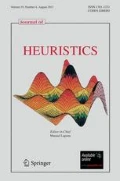Abstract
We consider the maximum covering problem, a combinatorial optimization problem that arises in many facility location problems. In this problem, a potential facility site covers a set of demand points. With each demand point, we associate a nonnegative weight. The task is to select a subset of p > 0 sites from the set of potential facility sites, such that the sum of weights of the covered demand points is maximized. We describe a greedy randomized adaptive search procedure (GRASP) for the maximum covering problem that finds good, though not necessarily optimum, placement configurations. We describe a well-known upper bound on the maximum coverage which can be computed by solving a linear program and show that on large instances, the GRASP can produce facility placements that are nearly optimal.
Similar content being viewed by others
References
Bennett, V.L., D.J. Eaton, and R.L. Church. (1982). “Selecting Sites for Rural Health Workers,” Social Science Medicine16, 63-72.
Chung, C.H. (1986). “Recent Applications of the Maximal Covering Location Planning (M.C.L.P.) Model,” Journal of the European Operational Research Society37, 735-746.
Church, R. and C. ReVelle. (1974). “The Maximal Covering Location Problem,” Papers of the Regional Science Association32, 101-118.
Daskin, M.S., P.C. Jones, and T.J. Lowe. (1990). “Rationalizing Tool Selection in a Flexible Manufacturing System for Sheet Metal Products,” Operations Research38, 1104-1115.
Dwyer, F.P. and J.R. Evans. (1981). “A Branch and Bound Algorithm for the List Selection Problem in Direct Mail Advertising,” Management Science27, 658-667.
Eaton, D.J., M.S. Daskin, D. Simmons, B. Bulloch, and G. Jansma. (1985). “Determining Medical Service Vehicle Deployment in Austin, Texas,” Interfaces15, 96-108.
Feo, T. and M. Resende. (1989). “A Probabilistic Heuristic for a Computationally Difficult Set Covering Problem,” Operations Research Letters8, 67-71.
Feo, T.A. and M.G.C. Resende. (1995). “Greedy Randomized Adaptive Search Procedures,” Journal of Global Optimization6, 109-133.
Klincewicz, J.G. (1992). “Avoiding Local Optima in the p-Hub Location Problem Using Tabu Search and GRASP,” Annals of Operations Research40, 283-302.
Resende, M.G.C., L.S. Pitsoulis, and P.M. Pardalos. (1997). “Approximate Solution of Weighted MAX-SAT Problems Using GRASP.” In D.-Z. Du, J. Gu, and P.M. Pardalos (eds.), The Satisfiability Problem: Theory and Applications, vol. 35 of DIMACS Series on Discrete Mathematics and Theoretical Computer Science. American Mathematical Society, Providence, RI. pp. 393-405.
Schilling, D., V. Jayaraman, and R. Barkhi. (1993). “A Review of Covering Problems in Facility Location,” Location Science1, 25-55.
Sweeney, D.J., R.L. Mairose, and R.K. Martin. (1979). “Strategic planning in Bank Location.” In AIDS Proceedings.
Author information
Authors and Affiliations
Rights and permissions
About this article
Cite this article
Resende, M.G. Computing Approximate Solutions of the Maximum Covering Problem with GRASP. Journal of Heuristics 4, 161–177 (1998). https://doi.org/10.1023/A:1009677613792
Issue Date:
DOI: https://doi.org/10.1023/A:1009677613792




